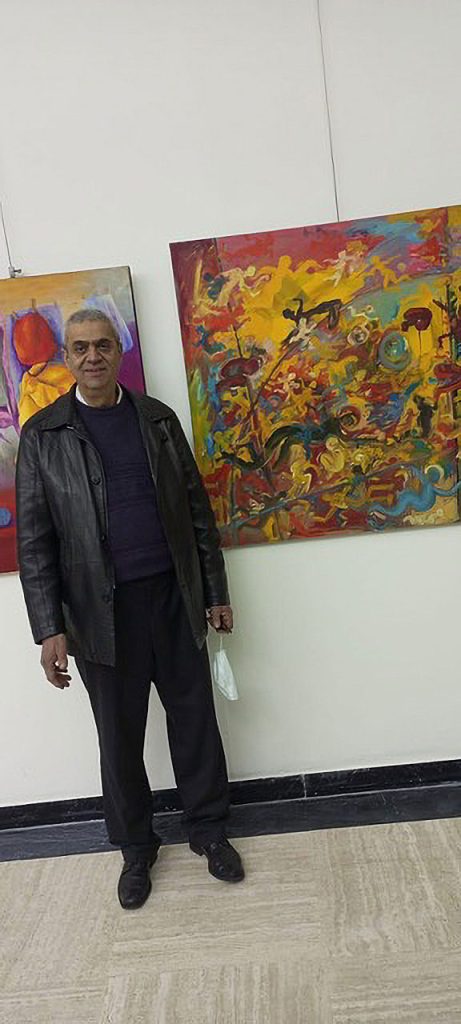For the Lebanese painter Joseph El Arid, the natural beauty, impressive architecture and community spirit of his birthplace have combined to provide lasting inspiration

While artists often cite fond memories of their childhood and birthplace when asked about their inspiration, the passion shown by the Lebanese painter Joseph El Arid for his home town of Zahle and surrounding areas in terms of output must surely be hard to equal.
“I’ve painted Zahle, Baalbek and the Bekaa too many times to remember – the light, the landscapes, the buildings and the people – I never get tired of capturing the beauty of the places and the love I feel for them and the people,” he said with a smile.
El Arid explained that as a boy, he worked in agriculture, meaning he was close to the land for much of the time and able to appreciate nature’s wonders from morning to night and throughout the seasons.

“I’d wake up early and immediately, my senses were filled with everything that nature had to offer, from the way the sun lit up the fields to the smell of the soil. It never failed to amaze me,” he said.
He also discovered a love for drawing and colouring in his early years, with the result that, almost inevitably, he found himself drawn to recreating his picturesque surroundings on paper.
Over the years, the rural landscapes around his hometown have provided a wealth of subject matter for El Arid, from the majestic, expansive cedars, reaching towards the sky, to the blossom billowing on the breeze and multi-coloured tapestry of flowers extending across the plains in spring, delicately depicted and celebrated.
Zahle’s impressive architecture, so deeply rooted in its heritage, is also a firm fixture in El Arid’s art, with the town’s houses, showcasing hallmark red roofs, and famous churches, brought to life through oils of vibrant colours.

The area’s rich history has also fed his imagination, as he explained. “At times, when I’m looking across the green plains, I can envisage the Romans cultivating the land centuries ago to feed their armies, and then picture the villagers doing the same in later years,” he said. “In fact, being in touch with the people who have lived and worked here over time and who bring life to their surroundings has always been very important to my work.”
While deciding what he wanted to paint has been straightforward for El Arid, his artistic journey was far from challenge free. The disruption of the civil war in Lebanon made it impossible to continue his studies, with the result that he was self-taught for many years. “It wasn’t easy, I had to push myself,” he admitted. “I used to do my own research, buying books, mixing colours and experimenting. It was a case of persevering until I saw improvements.”
He was eventually able to build on his own achievements by travelling abroad to study, spending time at the Royal Art Society of New South Wales in Sydney, Australia, and La Académie de la Grande Chaumière, Paris. These proved to be critical times in El Arid’s evolution as an artist, enabling him to hone his techniques and also expand his horizons by visiting several leading international museums and galleries.
“In Australia, I focused on sketches of the human body, still life and landscapes, while also discovering a wide range of art, including Aboriginal works, cubism, expressionism and impressionism,” he said.

Time spent in Paris, meanwhile, proved to be equally enlightening and enriching. “I have many wonderful memories of sketching and painting, mixing with great artists and teachers,” El Arid said. “Everything I saw and discovered abroad gave me the ability to build on what I’d taught myself in my humble beginnings.”
Having the opportunity to view the works of the great Impressionists up close while in Paris undoubtedly strengthened the connection El Arid felt to artists from that era and whose work has clearly influenced him. “I definitely have an affinity with this style,” he acknowledged. “Looking at the works of Monet, Manet, Van Gogh and Sisley, to name just a few, I certainly feel that I relate to their work, especially the landscapes.”

His rural scenes capture both the natural beauty and tranquillity of his birthplace, but El Arid is the first to admit that more recent events in Lebanon and elsewhere, from the country’s economic situation and the port explosion of August 4, 2020, to the war in Ukraine, have had an impact on his art.
“There is a sense of urgency, somehow, that has led to my art becoming more improvised, almost instant, in smaller neoexpressionist-style paintings,” he said. “I am keen to catch every sentiment, every pulse, through brushstrokes. It has also become more important than ever for my art to be meaningful. I’ve realised that we all have the same emotions and feelings wherever we are in the world – the hurt and anger – and I want to reflect the common bonds and scars we share with others. I find it comforting, almost like therapy.”
While the changes El Arid describes in his work are immediately perceptible to audiences, his passion for recreating the wonderful countryside around Zahle remains as strong as ever – a passion that he was encouraged to pursue years ago by the Lebanese painter Faouzi Al-Kach. “Faouzi told me to let nature be my teacher and I’ve always stayed true to that advice,” he said.

Leave a Reply